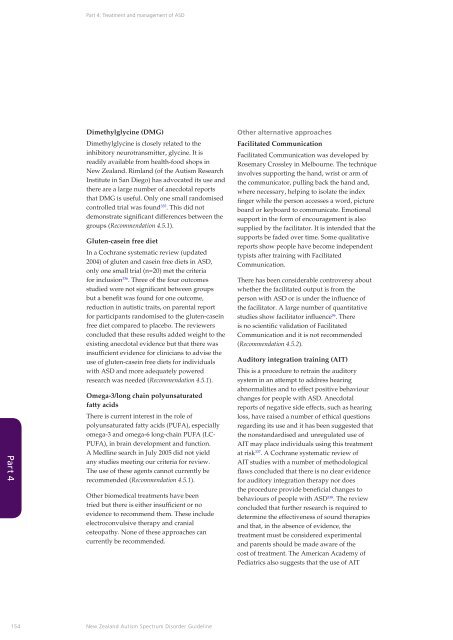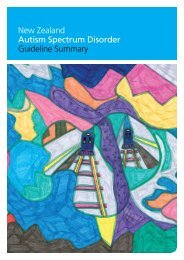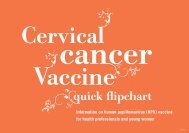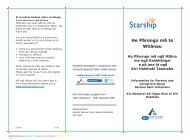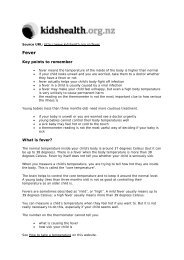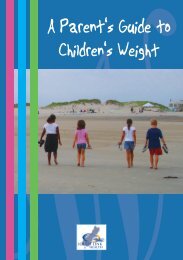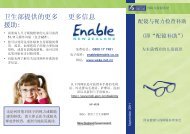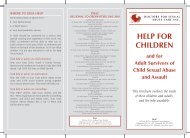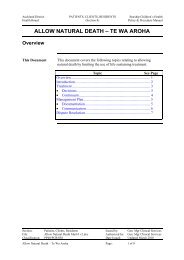New Zealand Autism Spectrum Disorder Guideline - Ministry of Health
New Zealand Autism Spectrum Disorder Guideline - Ministry of Health
New Zealand Autism Spectrum Disorder Guideline - Ministry of Health
You also want an ePaper? Increase the reach of your titles
YUMPU automatically turns print PDFs into web optimized ePapers that Google loves.
Part 4: Treatment and management <strong>of</strong> ASD<br />
Part 4<br />
Dimethylglycine (DMG)<br />
Dimethylglycine is closely related to the<br />
inhibitory neurotransmitter, glycine. It is<br />
readily available from health-food shops in<br />
<strong>New</strong> <strong>Zealand</strong>. Rimland (<strong>of</strong> the <strong>Autism</strong> Research<br />
Institute in San Diego) has advocated its use and<br />
there are a large number <strong>of</strong> anecdotal reports<br />
that DMG is useful. Only one small randomised<br />
controlled trial was found 335 . This did not<br />
demonstrate significant differences between the<br />
groups (Recommendation 4.5.1).<br />
Gluten-casein free diet<br />
In a Cochrane systematic review (updated<br />
2004) <strong>of</strong> gluten and casein free diets in ASD,<br />
only one small trial (n=20) met the criteria<br />
for inclusion 336 . Three <strong>of</strong> the four outcomes<br />
studied were not significant between groups<br />
but a benefit was found for one outcome,<br />
reduction in autistic traits, on parental report<br />
for participants randomised to the gluten-casein<br />
free diet compared to placebo. The reviewers<br />
concluded that these results added weight to the<br />
existing anecdotal evidence but that there was<br />
insufficient evidence for clinicians to advise the<br />
use <strong>of</strong> gluten-casein free diets for individuals<br />
with ASD and more adequately powered<br />
research was needed (Recommendation 4.5.1).<br />
Omega-3/long chain polyunsaturated<br />
fatty acids<br />
There is current interest in the role <strong>of</strong><br />
polyunsaturated fatty acids (PUFA), especially<br />
omega-3 and omega-6 long-chain PUFA (LC-<br />
PUFA), in brain development and function.<br />
A Medline search in July 2005 did not yield<br />
any studies meeting our criteria for review.<br />
The use <strong>of</strong> these agents cannot currently be<br />
recommended (Recommendation 4.5.1).<br />
Other biomedical treatments have been<br />
tried but there is either insufficient or no<br />
evidence to recommend them. These include<br />
electroconvulsive therapy and cranial<br />
osteopathy. None <strong>of</strong> these approaches can<br />
currently be recommended.<br />
Other alternative approaches<br />
Facilitated Communication<br />
Facilitated Communication was developed by<br />
Rosemary Crossley in Melbourne. The technique<br />
involves supporting the hand, wrist or arm <strong>of</strong><br />
the communicator, pulling back the hand and,<br />
where necessary, helping to isolate the index<br />
finger while the person accesses a word, picture<br />
board or keyboard to communicate. Emotional<br />
support in the form <strong>of</strong> encouragement is also<br />
supplied by the facilitator. It is intended that the<br />
supports be faded over time. Some qualitative<br />
reports show people have become independent<br />
typists after training with Facilitated<br />
Communication.<br />
There has been considerable controversy about<br />
whether the facilitated output is from the<br />
person with ASD or is under the influence <strong>of</strong><br />
the facilitator. A large number <strong>of</strong> quantitative<br />
studies show facilitator influence 96 . There<br />
is no scientific validation <strong>of</strong> Facilitated<br />
Communication and it is not recommended<br />
(Recommendation 4.5.2).<br />
Auditory integration training (AIT)<br />
This is a procedure to retrain the auditory<br />
system in an attempt to address hearing<br />
abnormalities and to effect positive behaviour<br />
changes for people with ASD. Anecdotal<br />
reports <strong>of</strong> negative side effects, such as hearing<br />
loss, have raised a number <strong>of</strong> ethical questions<br />
regarding its use and it has been suggested that<br />
the nonstandardised and unregulated use <strong>of</strong><br />
AIT may place individuals using this treatment<br />
at risk 337 . A Cochrane systematic review <strong>of</strong><br />
AIT studies with a number <strong>of</strong> methodological<br />
flaws concluded that there is no clear evidence<br />
for auditory integration therapy nor does<br />
the procedure provide beneficial changes to<br />
behaviours <strong>of</strong> people with ASD 338 . The review<br />
concluded that further research is required to<br />
determine the effectiveness <strong>of</strong> sound therapies<br />
and that, in the absence <strong>of</strong> evidence, the<br />
treatment must be considered experimental<br />
and parents should be made aware <strong>of</strong> the<br />
cost <strong>of</strong> treatment. The American Academy <strong>of</strong><br />
Pediatrics also suggests that the use <strong>of</strong> AIT<br />
154<br />
<strong>New</strong> <strong>Zealand</strong> <strong>Autism</strong> <strong>Spectrum</strong> <strong>Disorder</strong> <strong>Guideline</strong>


